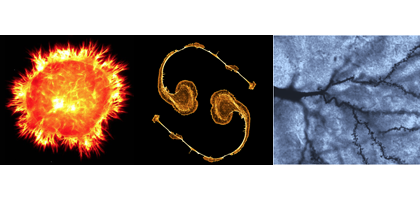This image of mouse embryonic fibroblasts comes from Cara Schiavon, a graduate student in Rick Kahn’s lab in the Department of Biochemistry. It was impressive enough to capture interest from Emory Medicine‘s graphics designer Peta Westmaas. The light green shapes are “Rods and Rings,” structures that were identified just a few years ago by scientists studying how cells respond to antiviral drugs, such as those used against hepatitis C.
The rod and ring structures appear to contain enzymes that cells use for synthesizing DNA building blocks. Patients treated with some antiviral drugs develop antibodies against these enzymes.
The turquoise color represents microtubules, components of cells’ internal skeletons. The orange color shows DNA within nuclei. The spots in the nuclei are areas where DNA is more compact. The overall image is a “z-stack projection” acquired using the Olympus FV1000 confocal microscope in Emory’s Integrated Cellular Imaging Core.





